Pow Wow
page 2
|
During a Pow Wow the dancers are expressing their own personal story, and so their Regalia helps to tell that story. In the old days the male Grass dancers would stomp down the grass in the place the Pow Wow would be held. Some of the dances do a very strong stomping movement and so those who danced that way were very useful. however, there was another reason for the stomping, they hoped that their Ancestors would hear the noise and come and join them in the dance, to help them tell their story. So the job was two-fold. All of the colors used in their Regalia have meanings, Native Peoples have different systems of what the colors mean. I use the system known to many Lakota/Dakota people which is as follows: WHITE = NORTH. A resting point on the wheel of life. Winter. Under the snow new life is forming, when the snow melts a new life begins. RED = EAST. Childhood on the wheel. Spring. Education, enlightenment. Spring. Sunrise. YELLOW = SOUTH. Growth, nurturing the stage of life when you care for your young or your crops. Summer, warmth. BLACK = WEST. Night, elder stage of life. Power from the Thunder-beings which bring the rain. Wisdom. BLUE = SKY. All that is above us in the Universe and beyond. GREEN = EARTH. The Mother Earth, the planet which gives everything a place to live and grow. This makes all of us on this planet relations, no matter who or what we are. Native Americans end their prayers with the words 'MITAKUYE OYASIN' which means 'We are all related'. It is a very powerful thought. WE ARE ALL RELATED. One of these colors at least will have a strong meaning to a dancer, especially if they are a Sundancer, and so their Regalia will feature that color more than any other. Often today though with all of the brightly colored cloth younger people tend to mix their colors completely, so the tradition doesn't show up so much. A Pow Wow is also called a Wacipi in
Dakota. |
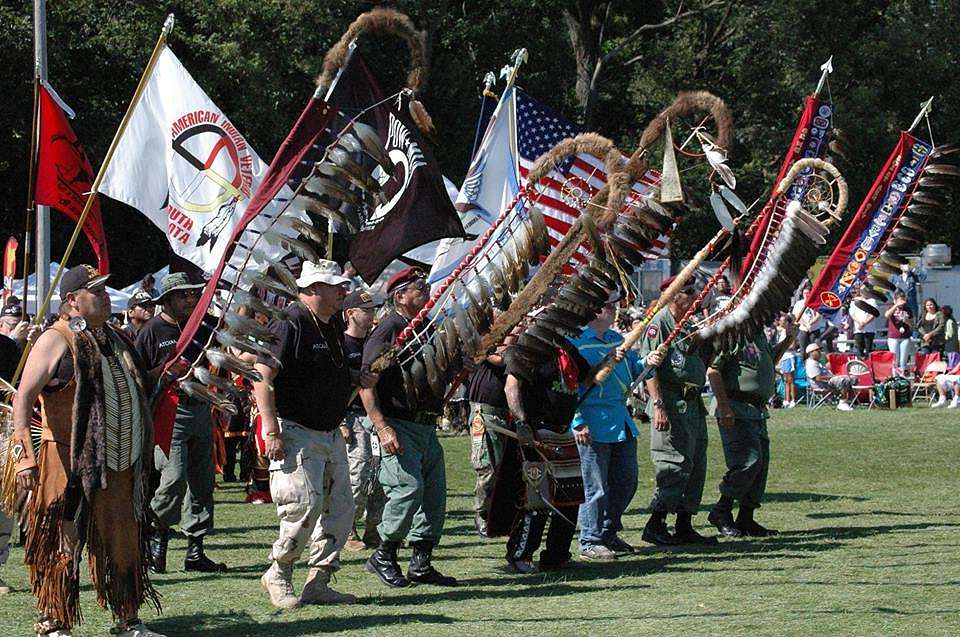
|
The photo above is a Grand Entry. This happens at the start of each day's dancing. veterans lead everyone in carrying the staffs and flags from the various Tribes and the USA. The Prisoner of War/Missing in Action flag is the black and white one, and is always represented. Eagle Feathers as I told you in the first post are very sacred to Native people. On the staffs you can see all of the Eagle feathers, some staffs have dream Catchers at the top, most have buffalo hide or a fur wound around the top bend of the staff. The staffs/flags will be stood up in a special holder and will stay there on show for the whole of the powwow. At the end another dance and ceremony is done to take them down. You can see that some of the men (now-days sometimes women) are in a military uniform, some are wearing traditional clothes, some just everyday clothes, ALL of them carrying these honor flags have been in the Military though, in different conflicts, in different branches of the services. On the two staffs on the right you can see all of the memberships they represent. Before the Grand Entry starts every one has to remove their hat, to show their respect of the flags/staffs. I remember I was at a powwow on the east Coast (NJ) back in the 1980's, way before I moved to MN, I was one of the people answering questions about the powwow or Natives in General. Different Tribes on the east Coast of course, I think this one was done by the Piscataway Tribe. Anyway the Master of Ceremonies, Jimmy Boy Dial, who I believe was Cherokee, was a stickler when it came to Veterans. and on this day he asked for hats to be removed, he asked again, still the Grand Entry did not start. I was standing behind Jimmy and I heard him say to the man next to him, 'Go speak to those men out there with hats on, I will not start until all of them have removed them.' and you know he didn't. When I looked around the arbour, not one person has their hat on, and only then was Jimmy happy. Most people standing were not too happy as it was hot! But true to his word he waited until everyone was showing respect. and then the Grand Entry started. |

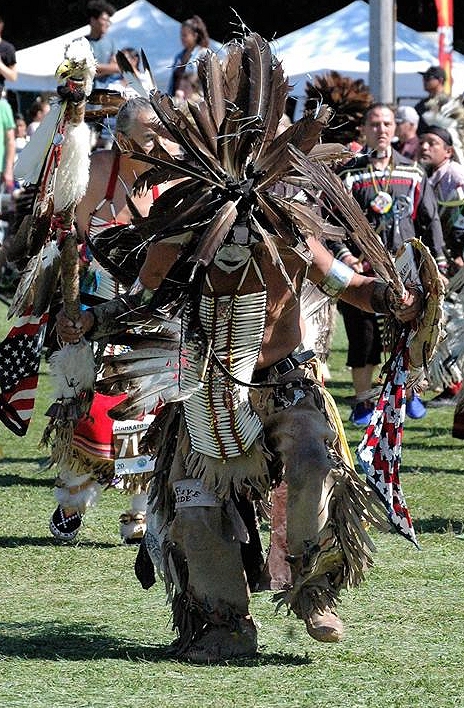
 An
Arikara/Mandan/Hidasa head-dress
An
Arikara/Mandan/Hidasa head-dress
|
Traditional men Dancers are in the 2 photos above. This is more like a war dance. the Regalia is buckskins, breast plates, fringing and Eagle feathers. The headresses are often very big, the North Dakota Tribe, Mandan/Arikara/Hidasa, wear a massive head-dress, I have only ever seen two of them, both stood out and were very impressive. (see small photo above from Google) My late husband Chuck was a traditional dancer when he was younger, he did dance as he got older but at the end he didn't wear the Regalia. He always danced so proudly, I loved watching him. |
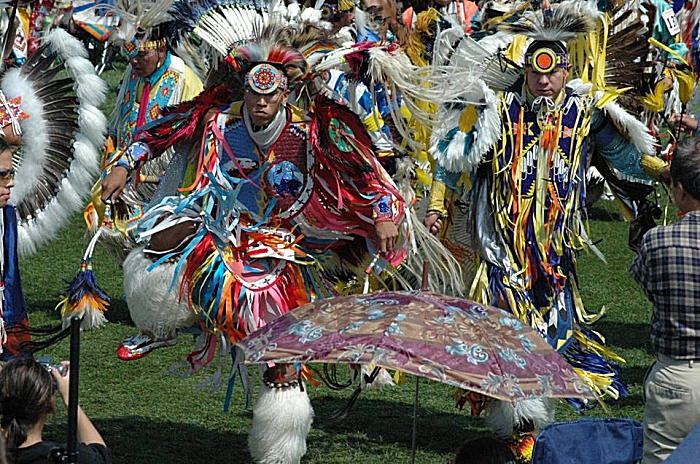
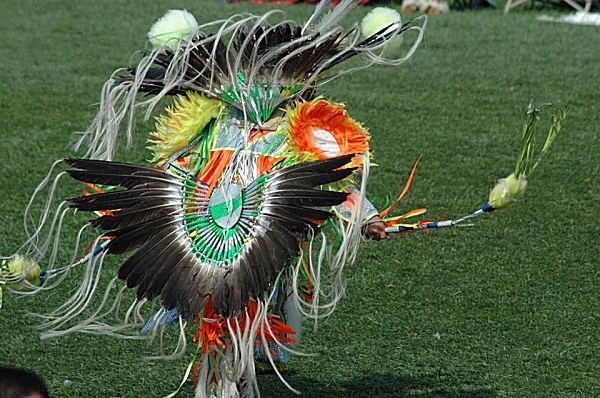
|
|
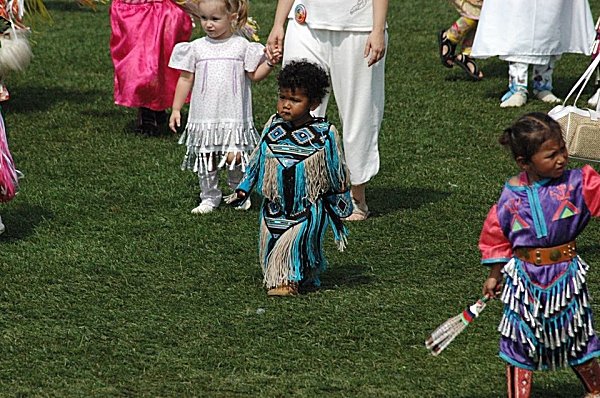
|
|
|
I was very sad to see in the photos I looked through for you that there were no women in traditional buckskins. I don't know why, maybe it was too hot, maybe they have gone out of fashion, or maybe those who danced that way have passed over. It was normally a dance for older women. However younger women had been taking the dance up. I haven't been to a pow wow for 10 years and so things could have changed. I googled some photos for you. See below: |
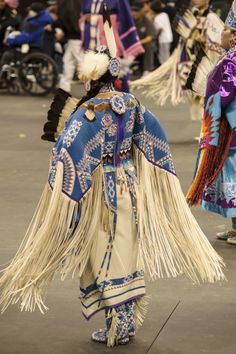

|
The best dresses are made from a white tanned suede. They have very long fringes on the arms. The tops are fully beaded as are the mocasins. Everything matches and they are beautiful. Traditionally they have 3 items attached to a belt on their waistband at the back. A knife, for cutting and skinning, a purse, to hold treasured objects and maybe medicines, sage, sweetgrass, or today money! and an awl, a pointed, handled instrument for making holes in leather. These are all fully beaded and amazing. (see pic below) These are items that were used by women in their daily work in the old days. They are worn to recognise and honor the women, their ancestors who used these tools.
The dance is very slow, the women bob up and down to the drum, if an honor song is done these women come down into the arbor and dance, very serenely, very respectfully. They stand straight and proud while they bob. Some of the better dancers can actually turn themselves in a circle just by bobbing. I can't. I can only bob! As they are bobbing the fringing moves with them back and forth, and when the music stops so the fringing has to stop moving immediately. Other materials for these dresses are velvet, satin, and blanket cloth. |

|
My own buckskin dress, only for show now. It is in an old style, no long fringing and not white. If I have forgotten anything I will add another page. I haven't mentioned the Drum, or honor songs. (I have a personal story of the Honor songs if you want it. Let me know.) Oh, yes, an Intertribal dance, is for anyone, powwow dancer or audience, so that means you or me. You just join in and walk or dance around the circle. Lots of people just walk slowly to the drum, talking to each other. if you do that you will see others on the outside of you dancing around the circle in their own way. A Pow Wow is a traditional way to meet friends and family. Some people take time off and travel 'the Circuit' meeting up with those they haven't seen since last year. There are monetary prizes for the best dances, (that is a fairly new part of the pow wow) If a dancer is one of the best the money he/she wins pays for him/her to go to different pow wows and compete. I prefer a traditional powwow where no money is involved, the people attending are fed by different families of the community for free. Another memory, of my first western pow wow experience in the early 1980's in Flandreau, SD. They had cooked a buffalo under the ground, being a big animal it took a long time to cook. When we were dished out the food I could see the meat was really rare, and I don't eat meat that way.... someone whispered to me, 'If that isn't done enough go over to that big tipi over there, they will help you'. So I did. I joined a queue and chatted while we waited. I expected a fire in there to cook the meat better, when I got to the door I was really surprised to see no fire, not a sign of one.... However, there was a microwave and that was what they were cooking the meat on. that was a surprise. I still laugh today at that. Gloria. |

